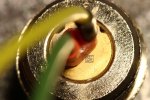
Welcome to Laser Pointer Forums - discuss green laser pointers, blue laser pointers, and all types of lasers
How to Register on LPF | LPF Donations
Navigation
Install the app
How to install the app on iOS
Follow along with the video below to see how to install our site as a web app on your home screen.
Note: This feature may not be available in some browsers.
More options

You are using an out of date browser. It may not display this or other websites correctly.
You should upgrade or use an alternative browser.
You should upgrade or use an alternative browser.
A-140 vs. M-140 vs. H1600
- Thread starter daguin
- Start date


lazeerer
0
- Joined
- May 25, 2010
- Messages
- 3,655
- Points
- 0
rhd did some testing here and then i did a few aswell:
http://laserpointerforums.com/f70/super-freak-445nm-diode-71285-4.html#post1038858
If we do a murder fund i would guess it would be best if we got a few diodes out of many different projectors so we can get a better overall idea of whats going on here. As if it is all from the same projector that wont give us enough info.
Iam in if its going to go down.:beer:
http://laserpointerforums.com/f70/super-freak-445nm-diode-71285-4.html#post1038858
If we do a murder fund i would guess it would be best if we got a few diodes out of many different projectors so we can get a better overall idea of whats going on here. As if it is all from the same projector that wont give us enough info.
Iam in if its going to go down.:beer:
- Joined
- Jul 4, 2008
- Messages
- 2,499
- Points
- 113
I was talking to LG display about projection technology on Friday with one of the engineers. Apparently LG is in the process in obtaining 4W 450nm diodes by a company called SORAA. Anyone know this company? LG will be producing a "pico-projector" using the 4W 450nm diodes and another true green LD diode with a peak emission at 130mW.
Apparently some of the new projectors already have the 4W diodes in them. It's likely some of you laser enthusiasts already have them in your possession, and don't even realize it yet. i have a feeling someones going to discover this by testing soon.
Apparently some of the new projectors already have the 4W diodes in them. It's likely some of you laser enthusiasts already have them in your possession, and don't even realize it yet. i have a feeling someones going to discover this by testing soon.
- Joined
- Jan 2, 2009
- Messages
- 11,800
- Points
- 0
If they are produced for Pico projectors, wouldn't they be micro diodes?
rhd
0
- Joined
- Dec 7, 2010
- Messages
- 8,469
- Points
- 0
I was talking to LG display about projection technology on Friday with one of the engineers. Apparently LG is in the process in obtaining 4W 450nm diodes by a company called SORAA. Anyone know this company? LG will be producing a "pico-projector" using the 4W 450nm diodes and another true green LD diode with a peak emission at 130mW.
Apparently some of the new projectors already have the 4W diodes in them. It's likely some of you laser enthusiasts already have them in your possession, and don't even realize it yet. i have a feeling someones going to discover this by testing soon.
It's interesting, it seems like 4W of blue would massively overbalance 130mW of green, even with eye sensitivity factored in.
You would also think that a 4W diode would be a poor choice for a pico projector. Even a really efficient 450nm diode would probably need at least 10W of input power (consider that we put 8W into our present 445s to get ~2W out).
So think about that - in a pico projector, to supply 10W of power to a diode, implies that the lithium ion battery will need to provide 10/3.7 = 2.7A of current, just for one of the diodes alone.
- Joined
- Jul 4, 2008
- Messages
- 2,499
- Points
- 113
I think I made a mistype...
The technician was talking about two different projectors.
The small "pico" projector will be using the Green diode from SORAA, the other projector a larger 4000 lumen projector will be using the 4W diodes from SORAA. It too will be part of a compact line of projectors. "Green projectors"
Basically the projector 4W SORAA diodes are in circulation right now. This comes directly from the engineer staff over at LG display.
These guys are very interesting to talk to! I have learned lots about the science behind display technology. It's amazing stuff!!
The technician was talking about two different projectors.
The small "pico" projector will be using the Green diode from SORAA, the other projector a larger 4000 lumen projector will be using the 4W diodes from SORAA. It too will be part of a compact line of projectors. "Green projectors"
Basically the projector 4W SORAA diodes are in circulation right now. This comes directly from the engineer staff over at LG display.
These guys are very interesting to talk to! I have learned lots about the science behind display technology. It's amazing stuff!!
Last edited:
rhd
0
- Joined
- Dec 7, 2010
- Messages
- 8,469
- Points
- 0
I think I made a mistype...
The technician was talking about two different projectors.
The small "pico" projector will be using the Green diode from SORAA, the other projector a larger 4000 lumen projector will be using the 4W diodes from SORAA. It too will be part of a compact line of projectors. "Green projectors"
Basically the projector 4W SORAA diodes are in circulation right now. This comes directly from the engineer staff over at LG display.
These guys are very interesting to talk to! I have learned lots about the science behind display technology. It's amazing stuff!!
I wonder what the release date will be for that?
And also whether they're using it for blue channel only, blue and green, or just green. And in any event, what they'll use for red?
(Mitsubishi 8W 635 array might be a logical pairing for the 4W Soraa)
- Joined
- Jul 4, 2008
- Messages
- 2,499
- Points
- 113
I wonder what the release date will be for that?
And also whether they're using it for blue channel only, blue and green, or just green. And in any event, what they'll use for red?
(Mitsubishi 8W 635 array might be a logical pairing for the 4W Soraa)
Same here I don't know about when that might be released. However I think I may ask a little bit more about the new DLP technology tomorrow and maybe by tomorrow evening have some more answers for you on that question.
I do know that there is in the works, a new diode that is very close to 520nm. Right now the closest to absolute green is 515 nm which is the diode that RHD has in his pointers now.
Last edited:
Benm
0
- Joined
- Aug 16, 2007
- Messages
- 7,896
- Points
- 113
It's an H-Series. If I get really ambitious at some point, I'll do the same with another diode from the projector. It would be valuable to know whether the number:
- Increments (suggesting that it's just a serial)
- Stays identical (suggesting a batch number, manufacture date, revision, etc)
- Is wildly difference (suggesting that the data may represent some diode-specific characteristics)
This should not be overly difficult to determine: If someone has a few of these diodes on hand, its easy to see if the barcodes are -identical- by naked eye. In that case they cannot be a serial or something containing diode specific data.
I would probably guess the barcode contains the following information:
- part type number
- manufacturing batch
To get to the bottom of it we'd need to get some of these codes for diodes that came out of the same projector, and from different projectors as well. Its usually not that hard to see whats chaging in a code as long as you have enough of them to find the pattern.
- Joined
- Jul 4, 2008
- Messages
- 2,499
- Points
- 113
Well you'd think identifying serial numbers is easy, but when it comes to these components, companies have a way of making it difficult to trace.
There is serious potential liability when hobbyists are using the parts of a DLP to build high power pointers. Casio has already responded strongly about the "misuse" of their diodes in the Wicked lasers (Arctic pointer).
There is serious potential liability when hobbyists are using the parts of a DLP to build high power pointers. Casio has already responded strongly about the "misuse" of their diodes in the Wicked lasers (Arctic pointer).
daguin
0
- Joined
- Mar 29, 2008
- Messages
- 15,989
- Points
- 113
Hi, everybody!
I am sorry for my bad English) looked this subject, but and did not understand, how marking of diodes of M - and a H-series differs? Whether there is at them a difference in output power? Or it is the same diode?
The A-series is different from the M and H series.
The M and the H series are identical to each other
The A-series uses one diode.
The M and the H series uses another diode
Peace,
dave
Blord
0
- Joined
- Dec 24, 2007
- Messages
- 5,356
- Points
- 0
i took a picture of my m140 data matrix. Can somebody decoder the matrix ?
3304940224



